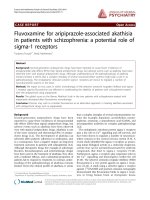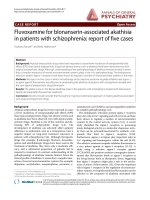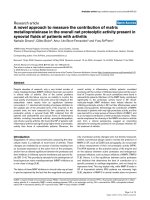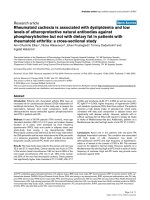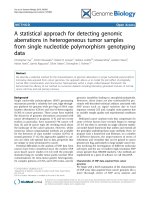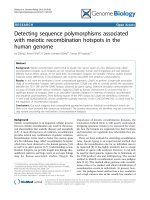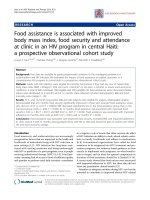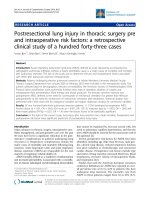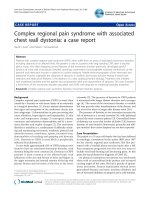Báo cáo y học: "Open lung approach associated with highfrequency oscillatory or low tidal volume mechanical ventilation improves respiratory function and minimizes lung injury in healthy and injured rats" ppt
Bạn đang xem bản rút gọn của tài liệu. Xem và tải ngay bản đầy đủ của tài liệu tại đây (452.6 KB, 14 trang )
RESEARC H Open Access
Open lung approach associated with high-
frequency oscillatory or low tidal volume
mechanical ventilation improves respiratory
function and minimizes lung injury in healthy
and injured rats
Joerg Krebs
1
, Paolo Pelosi
2
, Charalambos Tsagogiorgas
1
, Liesa Zoeller
1
, Patricia RM Rocco
3
, Benito Yard
4
,
Thomas Luecke
1*
Abstract
Introduction: To test the hypothesis that open lung (OL) ventilatory strategies using high-frequency oscillatory
ventilation (HFOV) or controlled mechanical ventilation (CMV) compared to CMV with lower positive end-expiratory
pressure (PEEP) improve respiratory function while minimizing lung injury as well as systemic inflammation, a
prospective randomized study was performed at a university animal laboratory using three different lung
conditions.
Methods: Seventy-eight adult male Wistar rats were randomly assigned to three groups: (1) uninjured (UI), (2)
saline washout (SW), and (3) intraperitoneal/intravenous Escherichia coli lipopolysaccharide (LPS)-induced lung
injury. Within each group, animals were further randomized to (1) OL with HFOV, (2) OL with CMV with “ best”
PEEP set according to the minimal static elastance of the respiratory system (BP-CMV), and (3) CMV with low
PEEP (LP-CMV). They were then ventilated for 6 hours. HFOV was set with mean airway pressure (P
meanHFOV
)at
2cmH
2
O above the mean airway pressure recorded at BP-CMV (P
meanBP-CMV
) following a recruitment
manoeuvre. Six animals serve d as unventilated controls (C). Gas-exchange, respiratory system mechan ics, lung
histology, plasma cytokines, as well as cytokines and types I and III procollagen (PCI and PCIII) mRNA expression
in lung tissue were measured.
Results: We found that (1) in both SW and LPS, HFOV and BP-CMV improved gas exchange and mechanics with
lower lung injury compared to LP-CMV, (2) in SW; HFOV yielded better oxygenation than BP-CMV; (3) in SW,
interleukin (IL)-6 mRNA expression was lower during BP-CMV and HFOV compared to LP-CMV, while in LPS
inflammatory response was independent of the ventilatory mode; and (4) PCIII mRNA expression decreased in all
groups and ventilatory modes, with the decrease being highest in LPS.
Conclusions: Open lung ventilatory strategies associated with HFOV or BP-CMV improved respiratory function and
minimized lung injury compared to LP-CMV. Therefore, HFOV with Pmean
HFOV
set 2 cm H
2
O above the Pmean
BP-
CMV
following a recruitment manoeuvre is as beneficial as BP-CMV.
* Correspondence:
1
Department of Anaesthesiology and Critical Care Medicine, University
Hospital Mannheim, Faculty of Medicine, University of Heidelberg, Theodor-
Kutzer Ufer, 1-3, 68165 Mannheim, Germany
Full list of author information is available at the end of the article
Krebs et al. Critical Care 2010, 14:R183
/>© 2010 Krebs et al.; licensee BioMed Central Ltd. This is an open access article distributed under the terms of the Creative Commons
Attribution License ( which permits unrestricted use, distribution, and reproduction in
any medium, provided the original work is properly cited
Introduction
Mechanical ventilati on is lifesaving for patients with
acute lung injury (ALI) a nd acute respiratory distress
syndrome (ARDS). However, it can cause ventilator-
induced lung injury through alveolar overdistension or
opening and closing of atelectatic lung regions [1].
None of the current strategies to prevent mechanical
ventilation injury in ALI/ARDS patients provides opti-
mal protection. For example, the standard of care for
controlled mechanical ventilation (CMV) in these
patients to prevent lung and distal organ injury [2] lim-
its tidal volume (V
T
) to 6 ml/kg predicted body weight
and end-inspiratory plateau pressur e (P
plat
) below 30 cm
H
2
O. However, low V
T
may not completely prevent
tidal hyperinflation [3], sometimes causing alveolar dere-
cruitment [4]. An “open lung” (OL) ventilatory strategy
based on recruitment manoeuvres (RMs) to open the
lung and on decreme ntal positive end-expiratory pres-
sure (PEEP) titration to set the “best PEEP” to maintain
the lung open [5] may result in systemic organ injury
because high PEEP levels may cause excessive parenchy-
mal stress and strain and have negative hemodynamic
effects [6,7].
In turn, high-frequency oscillatory vent ilation (HFOV)
[8] is characterized by the rapid delivery of small V
T
of
gas and the applic ation of high mean airway pressures.
These characteristics make HFOV conceptually attractive
as an ideal lung-protective ventilatory model, since high
mean airway pressure may prevent cyclical derecruitment
of the lung, and the small V
T
limits alveolar overdisten-
sion. HFOV has been shown to improve respiratory func-
tion and r educe the lung inflammatory response in
animal models [9]. However, it is unclear whether HFOV
helps reduce mortality or comorbidities in infants [10]
and adults [11] with ALI/ARDS. The adequate setting for
mean airway pressure during HFOV is a matter of
debate, with alternative approaches based on either a
standard table of recommended mean airway pressure
and oxygen concentration combinations or individual
titration matching the oxygenation response of each
patient [8]. Furthermore, it has been proposed that the
pathophysiology of ALI/ARDS may differ depending on
the type of insult [12], affecting the response to different
ventilatory strategies [13,14]. Therefore, it may be of
interest to assess the effects of predefined ventilatory
approaches in widely differing lung conditions.
We hypothesized that (1) an open lung (OL) approach
using HFOV (OL-HFOV) is more beneficial than OL-
CMV or low PEEP CMV, and (2) these ventilatory stra-
tegies may be affected by the underlying lung condition.
To investigate these hypotheses, we assessed the effects
of three ventilatory strategies (1) OL-HFOV, (2) OL-
CMV, and (3) low PEEP CMV in three experimental
scenarios: without injury, following saline washout (SW)
or lipopolysaccharide (LPS)-induced lung injury. The
SW has been conside red as an acute, direct lung inj ury
model, severely compromising gas-exchange and lung
mechanics, while the LPS model has been considered a
more chronic, “sepsis-like” model of indirect lung injury.
Therefore, this study did not aim to compare modes of
mechanical ventilation between these ALI models, but
to assess the effects of various ventilator strategy in each
model.
Materials and methods
The study wa s approved by the Institut ional Review
Board for the car e of animal subjects (University of Hei-
delberg, Mannheim, Germany). All animals received
humane care in compliance with the Principles of
Laboratory Animal Care formulated by the National
Society for Medical Research and the Guide for the
Care and Use of Laboratory Animals prepared by the
National Academy of Sciences, USA.
Animal preparation and experimental protocol
A total of 78 specific pathogen-free male Wistar rats
(450-5 00 g) housed in standard condition with food and
water given ad libitum were anesthetized by intraperito-
neal (IP) injection of ketamine hydrochloride (50 mg/kg)
and xylazine (2 mg/kg), with additional anaesthesia
administered as needed. The level of anaesthesia was
assessed by pinching the paw and tail throughout the
experiments. The femoral artery and both femoral veins
were cannulated with polyethylene catheter tubing (PE-
50; neoLab, Heidelberg, Germany). The arterial line was
used for continuous monitoring of heart rate (HR),
mean arterial pressure and to collect intermittent blood
samples (100 μl) for blood-gas analysis (Cobas b121,
Roche Diagnostics GmbH, Vienna, Austria). As soon as
veno us access was available, anaesthesia was maintained
with intravenous ketamine via an infusion pump (Braun
Perfusor Secura ft; B. Braun Melsungen AG, Melsungen,
Germany) at an initial rate of 20 mg/kg/hr. This infu-
sion rate was increased as needed to prevent sponta-
neous respiration after mechanical ventilation was
established. The animals were tracheotomised, intubated
with a 14-G polyethylene tube (Kliniject; KLINIKA
Medical GmbH, Usingen, Ge rmany) and mechanically
ventilated with a neonatal respirator (Babylog 8000;
Draeger, Luebeck, Germany) usin g a pressure-controlled
mode with a PEEP of 2 cm H
2
O, inspiratory/expira tory
ratio ( I:E) of 1:1 and fraction of inspired oxygen (FiO
2
)
of 0.5. This FiO
2
level was used throughout the entire
experimental period. End-insp iratory pressure (P
insp
)
was adjusted to maintain a V
T
of 6 ml/kg body weight.
A variable respiratory rate of 80-90 breaths/min was
Krebs et al. Critical Care 2010, 14:R183
/>Page 2 of 14
applied to maintain a PaCO
2
value within physiological
range. A catheter with a protected tip was inserted int o
the oesophagus for measurement of end-expiratory (P
es,
exp
) and end-inspiratory (P
es,insp
) oesophageal pressure.
The balloon catheter was first passed into the stomach
and then withdrawn to measure P
es
.Properballoon
position was confirmed in all animals by observing an
appropriate change in the pressure tracing as the bal-
loon was withdrawn into the thorax (changes in pres-
sure waveform, mean pressure and cardiac oscillation)
as well as by observing a transient increase in p ressure
duringagentlecompressionoftheabdomenas
described previously [15].
Norepinephrine (Arterenol; Aventis Pharma Deutsch-
land GmbH, Frankfurt am Main, Germany) was infused
with an additional fluid bolus of balanced electrolyte
solution (Deltajonin; Del taselect GmbH, Munich, Ger-
many) through the other venous line as needed to keep
systolic blood pressure above 60 mmHg. The total
volume of fluid administered was recorded. Body tem-
perature was maintained between 37 °C and 38.5 °C
with a heating pad. Paralyzing agents were not used.
The depth of anaesth esia was similar in all animals, and
a comparable amount of sedative and anaesthetic drugs
were administered in all groups.
Experimental protocol
A schematic flowchart of study design and the timeline
representation of the procedure are shown in Figure 1. In
the control (C) group (n = 6), animals were anaesthetized
as described above and immediately killed by exsanguina-
tion via the vena cava. The remaining 72 animals were
randomized into three groups (n =24each)and
mechanically ventilated for 6 hours as follows: (1) unin-
jured (UI), (2) lung injury induced by saline washout
(SW), and (3) lung injury induced by lipopolysaccharide
SW
n = 24
LPS
n = 24
n = 78
UI
n = 24
LP-CMV
n = 8
BP-CMV
n = 8
HFOV
n = 8
LP-CMV
n = 8
BP-CMV
n = 8
HFOV
n = 8
LP-CMV
n = 8
BP-CMV
n = 8
HFOV
n = 8
control
n = 6
RM/PT
RM/PT
BL
PEEP 2
BL
PEEP 6
BL
PEEP 2
RM/PT
RM/PT
RM/PT
RM/PT
RM/PT = recruitment manoeuvre/ PEEP trial
Figure 1 Schematic flow chart of the study design. UI, uninjured; SW, lung injury induced by saline washout; LPS, lung injury induced by
intraperitoneal/intravenous Escherichia coli lipopolysaccharide; BL, baseline measurements; RM/PT, recruitment manoeuvre followed by
decremental positive end-expiratory pressure (PEEP) trial; LP-CMV, controlled mechanical ventilation (CMV) with low PEEP; BP-CMV, controlled
mechanical ventilation (CMV) with “best” PEEP; HFOV, high-frequency oscillatory ventilation.
Krebs et al. Critical Care 2010, 14:R183
/>Page 3 of 14
(LPS; O55:B5) from Escherichia coli intraperitoneally/
intravenously injected. Saline washout injury was induced
as previously described [16]. Briefly, normal saline heated
to body temperature (30 ml/kg body weight) was inst illed
via the endotracheal tube and r emoved via gravity drai-
nage.Afterthefirstwashout,theratswerealternately
positioned on their left and right sides. After each lavage,
P
insp
was readjusted to deliver V
T
of 6 ml/kg body weight.
The procedure was repeated until a required P
insp
>22
cm H
2
O was obtained to maintain V
T
at 6 ml/kg body
weigh t and PaO
2
/FiO
2
below 100 mmHg. LPS injury was
performed as a two-hit model by administering a single
bolus of 1 mg/kg body weight intraperitoneally 24 hours
prior to the experiment, followed by a constant intrave-
nous infusion of LPS (1 mg/kg/hr) during the 6-hour
experimental period. Following injury, baseline measure-
ments were taken with PEEP set at the minimum level
identified in preliminary experiments to keep the animals
alive for 6 hours. In the UI and LPS groups, PEEP was set
at 2 cm H
2
O, while in the SW PEEP was set at 6 cm
H
2
O. Animals were further randomized into three sub-
groups (n = 8/each): (1) high frequency oscillatory venti-
lation (HFOV), (2) CMV with the “best” PEEP s et
according to the minimal respiratory system static ela-
stance (BP-CMV), and (3) CMV with low PEEP (LP-
CMV).
In the LP-CMV gro up, no recruitment manoeuvre
(RM) was applied and PEEP was kept at 2 cm H
2
O (in UI
and LPS groups) or 6 cm H
2
O (in SW group). In the BP-
CMV group, an open lung approach [5] was performed
by using a RM, applied as continuous positive airway
pressure of 25 cm H
2
O for 40 seconds, followed by a
decremental PEEP trial. Initial PEEP was set at 10 cm
H
2
O (in UI and LPS groups) or 16 cm H
2
O(inSW
group). P
insp
was adjusted to deliver a V
T
of 6 ml/kg body
weight. Thereafter, PEEP was reduced in steps of 2 cm
H
2
O, and changes in elasta nce were measured after a 10-
minute equilibration period. PEEP was reduced until the
elastanceoftherespiratorysystem(E
stat,RS
)nolonger
decreased. PEEP at minimum E
stat,RS
was defined as “best
PEEP”. Animals were then re-recruited, and “best-PEEP”
was applied throughout the experimental period. All
other ventilator settings remained unchanged. Airways
were not suctioned during the 6 hours of ventilation.
In the HFOV group, the RM and decremental PEEP
trial were performed as described for BP-CMV. Once
best PEEP was identified, mean airway pressure (P
mean
)
at BP-CMV (P
meanBP-CMV
) was recorded. Animals were
then switched to HFOV (SensorMedics 3100A; Care
Fusion, San Diego, CA, USA) and oscillated at a FiO
2
of
0.5, an I:E of 1:2 with a frequency of 15 Hz. P
meanHFOV
was set 2 cm H
2
O above P
meanBP-CMV
according to stan-
dard recommendations [8]. Pressure amplitude was
adjusted to maintain PaCO
2
within physiological ranges.
At the end of the experiment, a blood gas analysis was
performed. To assess respiratory mechanics, the animals
were switched back to CMV at the level of PEEP, initi-
ally defined as “best PEEP” with P
insp
readjusted to deli-
ver a V
T
of 6 ml/kg body weight for 2 minutes.
Respiratory mechanics were then assessed, after which
animals were immediately killed.
Respiratory system mechanics
Tracheal (P
trach
) and oesophageal (P
es
)pressureswere
recorded during 3 to 4 seconds of airway occlusion at
end expiration and end inspiration. E
stat,RS
was com-
puted as E
stat,rs
= ΔP
trach
/V
T
, where ΔP
trach
is the differ-
ence between end-inspiratory and end-expiratory
tracheal pressure. Static elastance of the chest wall (E
stat,
CW
) was computed as ΔP
es
/V
T
,whereΔP
es
is the differ-
ence between end-inspiratory and end-expiratory oeso-
phageal pressure. Static lung elastance (E
stat, L
)was
calculated as (E
stat,L
=E
stat,RS
-E
stat,CW
).
Histological examination
At the end of the experiment (6 hours), a laparotomy
was done immediately after the d etermination of lung
mechanics (End), and heparin (1,000 IU) was intrave-
nously injected. The trachea was clamped at 5 cm
H
2
O PEEP in all groups to standardize pressure condi-
tions. The abdominal aorta and vena cava were sec-
tioned, yielding a massive hae morrhage that quickly
killed the animals. Lungs were removed en bloc.The
right lungs were quick-frozen in nitrogen for mRNA
analysis. The left lungs were immersed in 4% formalin
andembeddedinparaffin.Four-μm- thick slice s were
cut and haematoxylin and eosin-stained. Morphological
examination was performed in a blinded fashion by
two i nvestigators using a conventional light microscope
at a magnification of ×100 across 10 random, noncoin-
cident microscopic fields. A five-point semiquantitative
severity-based scoring system was used as previously
described [17]. The pathological findings were graded
as negative = 0, slight = 1, moderate = 2, high = 3,
and severe = 4. The amount of intra- and extra-alveo-
lar haemorrhage, intra-alveolar oedema, inflammat ory
infiltration of the interalveolar septa and airspace,
atelectasis and overin flation were rated. The scoring
variables were added, and a histological total lung
injury score per slide was calculated.
Systemic inflammatory response
To assess the systemic infl ammatory response, the con-
centration o f tumour necrosis factor (TNF)-a,interleu-
kin (IL)-1 and IL-6 were measured in blood plasma after
the 6-hour experimentation period using the enzyme-
linked immuno sorb ent assay (ELISA) technique accord-
ing to the manufacturer’s instructions (R&D Systems
Krebs et al. Critical Care 2010, 14:R183
/>Page 4 of 14
Abingdon, UK). The blood samples were taken immedi-
ately before the animals were killed.
Real-time quantitative PCR
Total mRNA was extracted from the right lungs using
TriZOL reagent (Invitrogen GmbH, Karlsruhe, Ger-
many), digested with RNasefreeDNaseI(Invitrogen
GmbH) and reverse-transcribed into cDNA using Super-
sript II Reverse Transcriptase (Invitrogen GmbH)
according to manufacturer’s instructions. TaqMan™ real-
time polymerase cha in reaction (RT-PCR) was used for
quantitative measurement of mRNA expression of TNF-
a,IL-1b, IL-6 and (Pro-) Collagen I (PCI) and III
(PCIII) using commercially available primers (TaqMan™
gene expression assay; Applied Biosystems Applera
Deutschland GmbH, Darmstadt, Germany: Assay_ID: b-
Actin: Rn00667869_m1, TNFa Rn99999017_m1, IL6
Rn99999011_m1, IL1ß Rn00676330_m1, Col1A1
Rn01463848_m1, Col3A1 Rn01437681_m1). All samples
were measured in triplicate. Gene expression was nor-
malized to the housekeeping gene b-actin and expr essed
as fold change relative to control calculated with the
ΔΔCT method [18]. To rule out possible differences in
relative expression of different housekeeping genes, part
of the data was reanalyzed as post hoc data using glyc er-
aldehyde 3-phosphate dehydrogenase (GAPDH), leading
to comparable results (data not shown).
Statistical analysis
The normality of the data (Shapiro-Wilk test) and the
homogeneity of variances (Lev ene median test) were
tested. In case of p hysiological data, both conditions
were satisfied in all instances and thus two-way
ANOVA for repeated measures was used followed by
Holm-Sidak’s post hoc test when required. Physiol ogical
data are expressed as means ± SEM. Data from PCR
and ELISA analysis (expressed as median (25%-75%
quartiles)) were tested using Student’s t-test or Mann-
Whitney rank sum test when appropriate. Ratios (fold
changes), indicating the magnitude of response with
respect to unventilate d controls, were used for PCR
analyses. Statistical analyses were performed using Sig-
maPlot 11.0 (Systat Software GmbH, Erkrath, Germany).
The level of significance was set at P < 0.05.
Results
Effects of saline washout and LPS-induced lung injury at
baseline
Following saline washout, PEEP had to be increased
from 2 to 6 cm H
2
O as described above. Compared to
UI animals, SW injury pres ented higher P
insp
(12.3 ± 1.4
cm H
2
O vs.26.3±2cmH
2
O; P <0.001),E
stat,RS
(2.7 ±
0.5 cm H
2
O/ml vs.6.4±1cmH
2
O/ml; P <0.001),
PaCO
2
(44 ± 7.1 vs.57±8.9mmHg;P <0.001)and
lower PaO
2
/FiO
2
ratio (P/F, 474 ± 54 mmHg vs.76±
18 mmHg; P < 0.001).
Compared to UI animals, LPS showed lower P
insp
(12.3
±1.4cmH
2
O vs.10.9±0.8cmH
2
O; P <0.001)and
similar Estat, RS (2.7 ± 0.5 cm H
2
O/ml vs. 2.9 ± 0.4 cm
H
2
O/ml; P = 0.092), PaO
2
/FiO
2
ratio (474 ± 54 mmHg
vs. 453 ± 59 mmHg; P =0.07),orPaCO
2
(44.1 ± 7.1 vs.
46.3 ± 11.1 mmHg, P = 0.939). All baseline values in each
UI, SW, and LPS model were comparable (Table 1).
Best PEEP was set at 6.2 ± 0.5 cm H
2
OintheUI
group, 9.9 ± 1. 1 cm H
2
OintheSWgroup(P <0.001
vs.UIgroup)and5.3±1cmH
2
O(P =0.01vs.UI
group) in the LPS group (Figure 2).
Effects of LP-CMV, BP-CMV and HFOV
Respiratory system mechanics
After 6 hours in all groups, P
insp
was higher in the LP-
CMV compared to HFOV (Figure 2). E
stat,RS
increased
with time in LP-CMV in all groups. Additionally, with
HFOV, E
stat,RS
decreased with time in SW, while in LPS
E
stat,RS
increased with BP-CMV (Figure 3). All changes
in respiratory system mechanics observed within the
three m ain groups were attributable to changes in lung
mechanics, as E
stat,CW
did not change.
Gas exchange
In UI animals, no major effects of the ventilation modes
were observed on PaO
2
/FiO
2
ratio (Figure 4), but
PaCO
2
was more reduced in BP-CMV (33.5 ± 1.1
Table 1 Baseline parameters
UI SW LPS
LP-CMV BP-CMV HFOV LP-CMV BP-CMV HFOV LP-CMV BP-CMV HFOV
P
insp
11.8 ± 1.0 12.8 ± 2.0 12.4 ± 0.9 26.1 ± 2.0 25.6 ± 1.3 27.0 ± 2.5 11.2 ± 0.9 10,5 ± 0.8 11.3 ± 0.5
E
stat,RS
2.7 ± 0.5 2.7 ± 0.5 2.8 ± 0.3 6.4 ± 1.1 6.3 ± 0.7 6.8 ± 1.1 2.9 ± 0.3 2.8 ± 0.4 3.0 ± 0.4
PaO
2
/FiO
2
504.0 ± 17.4 481.5 ± 44.7 482.8 ± 70.6 73.1 ± 19.9 76.8 ± 17.9 78.0 ± 13.7 477.2 ± 48.6 428.5 ± 80.1 458.4 ± 33.3
PaCO
2
46.2 ± 5.3 39.2 ± 8.0 46.8 ± 5.7 56.6 ± 7.2 63.0 ± 7.2 53.8 ± 10.1 45.0 ± 8.2 44.7 ± 15.7 49.0 ± 8.1
UI, uninjured; SW, lung injury induced by saline washout; LPS, lung injury induced by intraperitoneal/intravenous E. coli lipopolysaccharide; BL, baseline
measurements; LP-CMV, controlled mechanical ventilation with low PEEP; BP-CMV, controlled mechanical ventilation with “best” PEEP; HFOV, high frequency
oscillatory ventilation; Pinsp, End-inspiratory plateau pressures at baseline; Estat, RS, Respiratory system elastance (Estat, RS) at baseline; PaO
2
/FiO
2
,PaO
2
/FiO
2
index at baseline; PaCO
2
, PaCO
2
at baseline. Values are means ± standard deviation. No significant differences were noted in the respective treatment groups at
baseline. UI, uninjured; SW, lung injury induced by saline washout; LPS, lung injury induced by intraperitoneal/intravenous E. coli lipopolysaccharide.
Krebs et al. Critical Care 2010, 14:R183
/>Page 5 of 14
mmHg) than in LP-CMV (42.91 ± 3.4 mmHg) at 6
hours (P = 0.006) (Figure 5). Compared to baseline,
HFOV also improved ventilatio n (PaCO
2
:46.8±2vs.
37.9 ± 1.8 mmHg; P = 0.007).
In SW animals, BP-CMV and HFOV presented a
greater PaO
2
/FiO
2
ratio at end compared to baseline
(P <0.001).TheincreaseinPaO
2
/FiO
2
ratio after 6
hours of HFOV was more pronounced than that of
BP-CMV (497.8 ± 13.8 vs. 250.8 ± 28.1 mmHg; P <
0.001) (Figure 4). PaCO
2
decreased after 6 hours of
HFOV compared to baseline and LP-CMV (Figure 5).
In LPS, there was a deterioration in PaO
2
/FiO
2
ratio in
LP-CMV and BP-CMV groups, which was more pro-
nounced in LP-CMV (P = 0.001). Six hours of LP-
CMV impaired ventilation (45 ± 3.1 vs. 54.5 ± 3.4
mmHg; P = 0.017). Conversely, HFOV reduced PaCO
2
(48.9 ± 2.9 vs. 40.1 ± 1.7 mmHg; P =0.02)withnosig-
nificant change in PaO
2
/FiO
2
ratio.
Histological examination
As shown in Figure 6, the histological total lung injury
score was higher in SW and LPS compared to UI. In UI,
ventilatory mode did not affect the histological total
lung injury score. In SW, the total lung injury score was
higher for LP-CMV compared to both BP-CMV and
HFOV. Following LPS injury, the total lung injury score
was higher in LP-CMV compared to BP-CMV.
In UI, LP-CMV induced more atelectasis (Table 2). In
SW, LP-CMV yielded higher oedema. In LPS, all ventila-
tory strategies led to higher inflammation compared to
UI and SW. Inflammation and atele ctasis were also
more intense in LP-CMV than in BP-CMV and HFOV
(Table 2).
Lung tissue inflammatory response
No differences in lung tissue inflammatory response
were observed with the use of different ventilatory
modes in UI animals. In SW animals ventilated with low
PEEP, IL-1b and IL-6 expression was higher compared
to BP-CMV and HFOV, respectively. IL-6 mRNA
expression was also increased in LPS anima ls ventilated
with LP-CMV compared to both open lung strategies
(Table 3). In LPS-injured lungs, HFOV caused less
TNF-a expression than BP-CMV.
Procollagen expression
In UI, PCI mRNA expression in lung tissue was higher
in BP-CMV compared to HFOV and LP-CMV, while no
differences were observed in the SW animals (Table 3).
LPS injury induced a substantial and unif orm decrease
in PCI mRNA expression.
Positive end expiratory pressure [cm H2O]
0
5
10
15
20
25
30
35
40
LP-CMV BP-CMV HFOV LP-CMV BP-CMV HFOV LP-CMV BP-CMV HFOV
inspiratory pressure [cm H2O ]
0
5
10
15
p<0.001
p=0.0025
p=0.001
p=0.01
p <0,001
p=0,016
UI SW LPS
Figure 2 End-inspirator y plateau pressures after 6 hours of mechanical ventilation. Bla ck bars r epre sent the l evel of PEEP. Values are
means ± SEM of eight animals in each group.
Krebs et al. Critical Care 2010, 14:R183
/>Page 6 of 14
0
2
4
6
8
10
12
14
LP-CMV BP-CMV HFOV LP-CMV BP-CMV HFOV LP-CMV BP-CMV HFOV
Elastance respiratory system [cm H2O/ml]
p < 0.001
p < 0.001
p < 0.001
p < 0.001
p < 0.001
p = 0.003
UI
SW
LPS
Figure 3 Respiratory system elastance (E
stat,RS
) after 6 hours of mechanical ventilation. Values are means ± SEM of eight animals in each
group.
0
100
200
300
400
500
600
LP-CMV BP-CMV HFOV LP-CMV BP-CMV HFOV LP-CMV BP-CMV HFOV
PaO2/FiO2 [mmHg]
p<0.001
p<0.001
p<0.001
p<0.001
p=0.001
UI
SW
LPS
Figure 4 PaO
2
/FiO
2
index after 6 hours of mechanical ventilation. Values are means ± SEM of eight animals in each group.
Krebs et al. Critical Care 2010, 14:R183
/>Page 7 of 14
0
10
20
30
40
50
60
70
LP-CMV BP-CMV HFOV LP-CMV BP-CMV HFOV LP-CMV BP-CMV HFOV
PaCO2 [mmHg]
UI
SW
LPS
p=0.006
p=0.015
p=0.006
p=0.025
Figure 5 PaCO
2
after 6 hours of mechanical ventilation. Values are means ± SEM of eight animals in each group.
LP-CMV BP-CMV HFOV LP-CMV BP-CMV HFOV LP-CMV BP-CMV HFOV
0.0
2.5
5.0
7.5
10.0
12.5
15.0
histological score [sum]
SW
UI
LPS
p=0.005
p=0.022
p=0.02
Figure 6 Histological total lung inj ury score. Boxes show interquartile (25%-75%) range, whiskers encompass range and horizontal lines
represent median value.
Krebs et al. Critical Care 2010, 14:R183
/>Page 8 of 14
Table 2 Histological lung injury score
UI SW LPS
Haemorrhage LP-CMV 0.0 (0.0/0.0) 0.0 (0.0/0.0) 2.0 (1.0/3.0)
BP-CMV 0.0 (0.0/0.0) 1.0 (0.0/1.0) 1.0 (1.0/3.0)
HFOV 0.0 (0.0/0.0) 1.0 (0.0/1.5) 2.0 (1.0/2.0)
Inflammation LP-CMV 1.0 (0.0/2.0) 2.0 (2.0/3.0) 4.0 (4.0/4.0)
a,b
BP-CMV 1.0 (0.75/1.0) 1.0 (1.0/2.0) 3.0 (3.0/4.0)
HFOV 1.0 (0.0/1.25) 2.0 (1.0/2.0) 3.0 (3.0/4.0)
Oedema LP-CMV 0.0 (0.0/0.0) 3.0 (2.5/4.0)
a,b
2.0 (1.0/2.0)
BP-CMV 0.0 (0.0/0.0) 0.0 (0.0/2.0) 2.0 (0.0/2.0)
HFOV 0.0 (0.0/0.0) 0.0 (0.0/0.0) 1.0 (0.0/2.0)
Atelectasis LP-CMV 2.5 (1.5/3.25)
b
2.0 (1.0/2.0) 2.5 (2.0/3.75)
a
BP-CMV 1.0 (1.0/2.0)
c
2.0 (1.0/2.5) 1.0 (0.0/2.0)
HFOV 0.0 (0.0/1.0) 1.0 (0.5/1.5) 1.0 (1.0/2.0)
Overinflation LP-CMV 0.0 (0.0/1.5)
a,b
2.0 (2.0/3.0) 1.0 (0.25/1.75)
BP-CMV 2.0 (1.75/3.25) 1.0 (1.0/2.0) 2.0 (1.0/2.0)
HFOV 2.0 (1.75/2.5) 2.0 (1.5/3.5) 3.0 (1.0/3.0)
Total lung injury score (sum) LP-CMV 4.0 (3.75/5.0) 10.0 (9.0/11.0)
a,b
12 (10.25/13.0)
a
BP-CMV 4.5 (3.0/6.0) 7.0 (5.5/7.5) 10.0 (8.0/10.0)
HFOV 3.5 (2.0/5.0) 6.0 (5.0/6.0) 10.0 (9.0/11.0)
Baseline measurements; LP-CMV, controlled mechanical with low PEEP; BP-CMV, controlled mechanical ventilation with “best” PEEP; HFOV, high-frequency
oscillatory ventilation. Values are medians and interquartile (25%-75%) range.
a
P < 0.05 LP-CMV vs. BP-CMV.
b
P < 0.05 LP-CMV vs. HFOV.
c
P < 0.05 BP-CMV vs.
HFOV.
Table 3 Lung inflammatory and fibrotic response
UI SW LPS
TNF-a LP-CMV 5.9 (4.6/7.8) 2.3 (1.9/2.9) 13.1 (12.2/15.5)
BP-CMV 6.0 (4.9/7.4) 2.8 (2.9/3.0) 21.1 (12.8/24.1)
c
HFOV 6.5 (3.7/7.4) 3.5 (1.8/4.0) 12.7 (11.6/15.6)
Interleukin-1b LP-CMV 6.4 (4.6/7.5) 2.9 (2.4/6.1)
a,b
8.4 (7.6/9.9)
BP-CMV 4.5 (3.5/6.6) 2.2 (1.5/3.0)* 10.4 (8.3/11.1
HFOV 4.3 (3.7/5.9) 2.2 (1.8/3.2)* 9.5 (8.4/11.2)
Interleukin-6 LP-CMV 24.0 (10.2/30.5) 625.2 (399.8/880.0)
a,b
1278.5 (1187.4/1390.2)
a,b
BP-CMV 16.0 (6.7/23.7) 380.7 (205.4/417.5) 498.4 (381.2/568.2)
HFOV 5.7 (3.6/14.7) 367.4 (182.9/496.1) 446.1 (252.6/563.8)
Procollagen I LP-CMV 1.0 (0.8/1.2)*
a
0.5 (0.6/0.8)* 0.4 (0.3/0.4)
BP-CMV 1.4 (1.1/2.0)
c
0.6 (0.5/1.2)* 0.2 (0.1/0.4)
HFOV* 1.0 (0.7/1.5)* 0.8 (0.4/1.0)* 0.3 (0.3/0.5)
Procollagen III LP-CMV 0.5 (0.5/0.6) 0.3 (0.2/0.4) 0.2 (0.1/0.2)
BP-CMV 0.6 (0.5/0.8) 0.3 (0.2/0.3) 0.2 (0.1/0.3)
HFOV 0.5 (0.4/0.6) 0.3 (0.2/0.3) 0.2 (0.2/0.3)
UI, uninjured; SW, lung injury induced by saline washout; LPS, lung injury induced by intraperitoneal/intravenous E. coli lipopolysaccharide; LP-CMV, controlled
mechanical ventilation with low PEEP; BP-CMV, controlled mechanical ventilation with “ best” PEEP; HFOV, high frequency oscillatory ventilation. Values are
medians and interquartile (25%-75%) range and are presented as fold changes relative to unventilated control group. *P > 0.05 vs. unventilated control group.
a
P < 0.05 LP-CMV vs. BP-CMV.
b
P < 0.05 LP-CMV vs.HFOV.
c
P < 0.05 BP-CMV vs. HFOV.
Krebs et al. Critical Care 2010, 14:R183
/>Page 9 of 14
PCIII mRNA expression was significantly a nd uni-
formly lower throughout all g roups and modes of MV
compared to unventilated controls, with the reduction
being most pronounced following LPS (Table 3).
Systemic inflammatory response
The systemic inflammatory response elicited by 6 hours
of ventilation of uninjured lungs was lower for HFOV
compared to both LP-CMV and BP-CMV (Table 4). In
SW animals ventilated with low PEEP, systemic IL-6
levels were higher compared to BP-CMV.
Following 6 hours of intravenous infusion of LPS, a
uniform massive inflammatory response was observed
with only very minor differences in IL-1b favouring
HFOV. This massive inflammatory response was also
reflected by higher dose requirements of norepinephrine
and additional fluid to maintain a systolic blood pres-
sure above 60 mmHg compared to SW and UI groups.
There were no differences within groups for fluid and
norepinephrine requirements, respectively.
Discussion
In the present study, we investigated the effects of “open
lung” strategies using HFOV or CMV (BP-CMV) com-
pared to low-PEEP CMV (LP-CMV) on gas-exchange,
hemodynamic, respiratory system static elastance, pul-
monary histology, cytokines and types I and III procolla-
gen (PCI and PCIII) mRNA expression in lung tiss ue as
well as plasma cytokines following 6 hours of mechani-
cal ventilation. W e found that (1) in the UI group, BP-
CMV and HFOV compared to LP-CMV did not provide
major benefits except for maintaining respiratory system
static elastance; (2) in both SW and LPS groups, HFOV
and BP-CMV improved gas exchange and mechanics
with lower lung injury scores compared to LP-CMV; (3)
in the SW group, HFOV yielded better oxygenation
than BP-CMV; (4) in SW group, IL-6 mRNA expression
was lower during BP-CMV or HFOV compared to LP-
CMV, while in the LPS group inflammatory response
remained largely independent of ventilatory mode; and
(5) PCIII mRNA expression decreased in all groups and
ventilatory modes, mainly in the LPS model.
We observed that “open lung” ventilatory stra tegies
using HFOV or CMV improved respiratory function
and m inimized lung injury compared to LP-CMV. Set-
ting P
meanHFOV
2cmH
2
O above the P
meanBP-CMV
fol-
lowing a recruitment manoeuvre is as beneficial as BP-
CMV. Both open lung strategies were able to reduce the
biotrauma as assessed by pulmonary IL-6 expression
compared to LP-CMV. The fact that no major diffe r-
ences in IL-6 expression during HFOV and BP-CMV
were observed suggests the limited ability of HFOV to
minimize biotrauma compared to optimized conven-
tional ventilatory approaches. To assess the effects of
the underlying lung injury model, ventilatory strategies
were tested in three different situations: without injury
and following SW and LPS lung injury. We tested unin-
jured animals because the effects of “open lung” strate-
gies during general anaesthesia and paralysis in healthy
lungs are a matter of debate [19]. The SW model was
chosen because it provides an ideal way to test the
effects of d ifferent ventilatory strategies on the develop-
ment of tissue injury. In fact, tis sue injury resu lts more
from the ventilatory strategy than from the saline lavage,
as surfactant depletion facilitates alveolar collapse and
increases the likelihood of mechanical injury to the
alveolar walls during repeated cycles of opening/closing
unless optimum PEEP is applied [20]. Also, SW pro-
foundly affects lung mechanics and gas exchange
[16,21]. The LPS model was selected because it mimic s
a situation of sepsis [22] and because it is characterized
by direct endothelial insult, but without significant
impact on lung mechanics [ 23]. We used a two-hit
Table 4 Systemic inflammatory response
Control UI SW LPS
TNF-a (pg/ml) 0 (0/0) LP-CMV 18.0 (15.0/29.0) 0 (0/17.75)* 52.0 (45.0/136.5)
BP-CMV 49.0 (20.0/55.5)
c
0 (0/0)* 34.0 (26.25/48.75)
HFOV 9.0 (9.0/16.5) 0 (0/0)* 29.5 (27.0/39.25)
Interleukin-1b (pg/ml) 19.5 (15.5/24.25) LP-CMV 17.5 (15.0/24.25)
b
11.5 (0/26.25) 51.0 (47.0/117.0)
b
BP-CMV 16.5 (15.0/34.5)
c
0 (0/5.5) 46.0 (36.0/265.25)
c
HFOV 0 (0/0) 6 (0/6.25) 31.5 (23.5/33.25)
Interleukin-6 (pg/ml) 41.0 (34.0/48.0) LP-CMV 232.0 (187.0/290.0)
b
185.0 (149.0/218.0)
a
22320.0 (16375.0/65440.0)
BP-CMV 262.0 (232.0/276.0)
c
53.0 (40.0/127.5) 14395.0 (9300.0/54967.5)
HFOV 78.0 (55.0/145.5) 169.0 (95.5/239.0) 35930.0 (20090.0/43025.0)
UI, uninjured; SW, lung injury induced by saline washout; LPS, lung injury induced by intraperitoneal/intravenous E. coli lipopolysaccharide; BL, baseline
measurements; LP-CMV, controlled mechanical ventilation with low PEEP; BP-CMV, controlled mechanical ventilation with “best” PEEP; HFOV, high frequency
oscillatory ventilation. Values are medians and interquartile (25%-75%) range.
a
P < 0.05 LP-CMV vs. BP-CMV.
b
P < 0.05 LP-CMV vs. HFOV.
c
P < 0.05 BP-CMV vs.
HFOV.
Krebs et al. Critical Care 2010, 14:R183
/>Page 10 of 14
model with LPS applied intraperitoneally 24 hours
before and by continuous intraven ous infusion through-
out the experimental period, resulting in a massive sys-
temic and pulmonary inflammatory response as well as
high histological injury scores.
The “best” PEEP during CMV was set according to
the lower static elastance of the r espirato ry system dur-
ing a decremental PEEP trial following a RM. Differently
from gas exchange, lung mechanics are not affected by
changes in regional perfusion [24] and are mainly deter-
mined by changes in pulmonary structure [25]. In addi-
tion, RM has been found effective to optimize
recruitment before PEEP application [26].
The expression of different inflammatory and fibro-
genic mediators in the lung tissue was measured. PCI
and PCIII mRNA expressions were analyzed to better
understand the different moments of fibrogenesis. Type
III collagen fibre is more flexible and susceptible to
breakdown and predominates early in the course of lung
injury, whereas type I collagen (composed of thicker and
cross-linked fibrils) is more prevalent in the late phase
[27].
The effects of different ventilatory strategies are dis-
cussed i ndividually for each of the three groups, since it
was not the aim of our study to compare modes of ven-
tilation across injury models.
Uninjured animals
In uninjured animals, LP-CMV compared to BP-CMV
and HFOV maintained gas exchange and increased sta-
tic elastance of the respiratory system but did not pro-
mote lung injury. As expected, we observed a high
amount of atelectasis in LP-CMV and none in BP-CMV
and HFOV. Conversely, more overinfla tion was seen in
BP-CMV and HFOV. Increased atelectasis may explain
the rise in static elastance after 6 hours of mechanical
ventilation. Although PEEP between 3 to 5 cm H
2
O
associated with low tidal volume has been used as a
lung-protective strategy, we found significant differences
between PEEP 2 cm H
2
O (low PEEP) and 6 cm H
2
O
(best PEEP) regarding mechanics and atelectasis. This
may be due to the fact that the experimental period in
our study was prolonged to 6 hours compared to 1 hour
in most comparable studies.
Overall lung inflammatory response, as assessed by
mRNA expression of TNF-a,IL-1b and IL-6, showed
no major differences among ventilatory modes. PCI
mRNA expression in lung tissue increased in BP-CMV
compared to LP-CMV, HFOV and unventilated con-
trols. On the other hand, PCIII mRNA expression uni-
formly decreased after 6 hours in LP-CMV, BP-CMV or
HFOV. PCIII mRNA expression has been reported to be
an early marker of lung parenchyma remodelling
[14,17,28,29] and shown to be higher in lungs subjected
to elevated airway pressur es [14,17], high infla tion [30]
or cyclic mechanical strain [29]. In a recent study, San-
tana and co-workers [31] showed unchanged PCIII
mRNA expression in lung tissue following 1 hour of
MV at low V
T
and zero end-expiratory pressure in
uninjured rat lungs. Our study is the first to report
decreased PCIII mRNA expression after 6 hours of low
V
T
ventilation using low or “best” PEEP. Conver sely, we
observed increased levels of PCI mRNA in animals ven-
tilated with BP-CMV, which may be attribut ed to
increased pulmonary stress and strain [31]. These differ-
ences may be related to (1) the different experimental
time period (6 hours in the present study vs. 1 hour in
previous studies) [14,17,28-32] and (2) the use of low
PEEP level.
Saline lavage and LPS-induced lung injury
These two models induced major functional and histolo-
gical differences. SW was characterized by higher static
elastance of the respiratory system, oedema and overin-
flation, with major deterioration in gas exchange. It can-
notberuledoutthatpartoftheoedemaobserved
histologically in the SW animals was associated with sal-
ine not reabsorbed or removed during the lavage pro-
cess. As baseline parameters were comparable for all
SW animals, we can speculate that this potential e rror
does not interfere with the validity of the results. Com-
pared to SW, LPS was characterized by more inflamma-
tion, h aemorrhage and atelectasis. In both ALI models,
LP-CMV compared to BP-CMV and HFOV resulted in
deterioration of gas exchange, respiratory system
mechanics and lung histology.
Our data suggest that LP-CMV-induced injury is dif-
ferent in relation to initial damage as compared to BP-
CMV and HFOV: higher leakage and alveolar oedema in
SW [32], with less epithelial-endothelial damage with
migration of neutrophils, inflammation and marked
interstitial oedema with atelectasis formation in LPS
[20]. LPS promotes systemic inflammation that could
prime alveolar macrophages a posteriori, but initially
LPS does not cause severe endothelial/epithelial damag e
[23].
On the other hand, HFOV, but not BP-CMV, was able
to maintain oxygenation and lung mechanics in LPS,
which suggests a potential role for HFOV early in the
course of severe sepsis. These beneficial effects are prob-
ably related to t he higher mean airway pressures during
HFOV. It should be noted, however, that these increased
airway pressures did not cause haemodynamic compro-
mise or increased fluid or norepinephrine requirements
in HFOV animals compared to BP-CMV or LP-CMV.
The increased shear stress and strai n imposed by open-
ing and stretching of collapsed lung in the dependent
regions due to insufficient levels of PEEP was probably
Krebs et al. Critical Care 2010, 14:R183
/>Page 11 of 14
high enough to stimulate an increased parenchymal
inflammatory response as assessed by elevated levels of
IL-6 mRNA expression in the lung tissue. IL-6, differ-
ently from TNF-a or IL-1 b, is expressed and released
during several hours and may therefore be more suitable
to assess the effects of the ventilatory strategies used
[33].
After 6 hours of MV and PCIII, but not PCI, mRNA
expression was signi ficantly and uniformly lower com-
pared to unventilated controls independent of ventila-
tory mode in the ALI experimental model. This finding
is in contrast to previous studies mostly showing that
short-term (1 hour) “lung-protective” MV does not alter
PCIII mRNA expression in lung tissue in different
experimental models of ALI, while less protective modes
result in increased PCIII mRNA expression [17,28-31].
It is likely that time can play a relevant role in deter-
mining different activation in collagen response; how-
ever, we are not aware of any previous study
investigating the kinetics of collagen formation within
the first 6 hours after ALI. We could speculate that
inflammation, and probably IL-6, may promote a reduc-
tion in collagen synthesis [34]. Further studies are
required to address these issues.
The systemic inflammatory response was higher in
LPS compared to SW [21,23] but was unaffected by dif-
ferent ventilatory modes, as previously reported [35,36].
Thus, our data suggest that the local, and not the sys-
temic, inflammatory response should be taken into
account when evaluating lung injury induced by differ-
ent ventilatory treatments. Furthermore, the systemic
response appears to be more correlated with factors that
are external to the lung.
Limitations
The current study has several limitations that need to be
addressed. First, PEEP levels were not identical in the
three modes across groups, since low PEEP had to be
set at 6 cm H
2
O in SW compared to 2 cm H
2
OinUI
and LPS in LP-CMV animals to prevent detrimental
hypoxemia. Likewise, PEEP levels (BP-CMV) and
P
meanBP-CMV
(HFOV) were different between groups as
they were individually titrated. However, the primary
aim of the study was to compare three defined ventila-
tory strategies in different lung conditions rather than
compare the individual str ategies between groups. Sec-
ond, we studied three ventilatory strategies in different
lung conditions: uninjured lungs, animals undergoing
acute saline lung lavage as well as an imals exposed to
LPS already 24 ho urs prior to the experiment as part of
a “double-hit” injury. This “double hit” approach was
used to get a stable and reproducible LPS model. There-
fore, this study comprises data on the effects of different
ventilatory strategies not only for different types of
injury but also for noncomparable injury “ tim es”.Our
aim was to assess the effectiveness of open-lung ventila-
tory strategies over a wide range of lung conditions
rather than compare theses different lung conditions.
Therefore, the different timing of injury does not neces-
sarily interfere with a proper analysis of the results.
Third, additional fluid was given to LPS animals to
maintain haemodynamics. While this may promote
oedema formation, fluid administration is a key element
of resuscitation in septic shock. As i dentical amounts of
fluid w ere given to each LPS animal, the interpretation
of data within the LPS group was not affected.
Fourth, some methodological issues regarding the
method used for RNA quantification of collagen turn-
over in this study compared to other studies deserve to
be mentioned. Assuming that differences in t he overall
collagen RNA turnover in the different treatment groups
during our short observation period might be rather
low, we utilized the TaqMan™ PCR system for real-time
RNA quantification, which is considered one of the best
quantitative [37] and most sensitive [38] approaches for
measurement of RNA currently available. In contrast to
most studies so far, we used the housekeeping b-actin
gene rather than GAPDH as reference gene, but this did
not interfere with our results.
Conclusions
In different animal ALI models, open lung ventilatory
strategies using HFOV or CMV improved respiratory
function and minimized lung injury compared to LP-
CMV. Open lung HFOV with P
meanHFOV
set 2 cmH
2
O
above the P
meanBP-CMV
following a recruitment man-
oeuvre is as beneficial as BP-CMV.
Key messages
• Open lung ventilatory strategies associated with
HFOV or best PEEP (BP)-CMV improved respira-
tory function and minimized lung injury more than
low PEEP (LP)-CMV.
• HFOV with P
meanHFOV
set 2 cm H
2
Oabovethe
P
meanBP-CMV
following a recruitment manoeuvre was
as beneficial as BP-CMV.
• After 6 hours of protective ventilation, PCIII
mRNA expression was significantly and uniformly
lower compared to unventilated cont rols in all
groups and modes of MV.
Abbreviations
ALI: acute lung injury; ARDS: adult respiratory distress syndrome; BP: best
PEEP; E
stat
,
RS
: static respiratory system elastance; E
stat,l
: static lung elastance;
E
stat,cw
: static chest wall elastance; IL: interleukin; LP: low PEEP; LPS:
lipopolysaccharide; PC: procollagen; PCR: polymerase chain reaction; PEEP:
positive end-expiratory pressure; P
es
: oesophageal pressure; P
plat
: inspiratory
plateau pressure; RM: recruitment manoeuvre; SW: saline washout; V
T
: tidal
volume; ZEEP: zero end-expiratory pressure.
Krebs et al. Critical Care 2010, 14:R183
/>Page 12 of 14
Acknowledgements
The authors thank Paula Sternik and Jutta Schulte for their invaluable help in
performing ELISA and TaqMan procedures. We further thank Petra
Prochatzka and Vicki Skude for assistance in the animal experiments and
Christel Weiss, Department of Medical Statistics, University Hospital
Mannheim, Germany, for statistical advice.
Author details
1
Department of Anaesthesiology and Critical Care Medicine, University
Hospital Mannheim, Faculty of Medicine, University of Heidelberg, Theodor-
Kutzer Ufer, 1-3, 68165 Mannheim, Germany.
2
Department of Ambient,
Health and Safety, University of Insubria, Sevizio di Anesthesia B, Ospedale di
Circolo e Fondazione Macchi viale Borri 57, 21100 Varese, Italy.
3
Laboratory
of Pulmonary Investigation, Carlos Chagas Filho Biophysics Insti tute, Federal
University of Rio de Janeiro, Av. Carlos Chagas Filho, s/n, Rio de Janeiro,
21949-902, Brazil.
4
Department of Internal Medicine V University Hospital
Mannheim, Faculty of Medicine, University of Heidelberg, Mannheim,
Germany, Theodor-Kutzer Ufer 1-3, 68165 Mannheim, Germany.
Authors’ contributions
JK, PP and TL participated in the study design. JK, CT, LZ, BY and TL
performed the study. JK, PP, BY and TL processed the data and performed
the statistical analysis. JK, PP, PRMR and TL wrote the manuscript. All authors
revised the manuscript and approved its final version.
Competing interests
The authors declare that they have no competing interests.
Received: 15 March 2010 Revised: 10 June 2010
Accepted: 14 October 2010 Published: 14 October 2010
References
1. Dreyfuss D, Saumon G: Ventilator-induced lung injury: lessons from
experimental studies. Am J Respir Crit Care Med 1998, 157:294-323.
2. Putensen C, Theuerkauf N, Zinserling J, Wrigge H, Pelosi P: Meta-analysis:
ventilation strategies and outcomes of the acute respiratory distress
syndrome and acute lung injury. Ann Intern Med 2009, 151:566-576.
3. Terragni PP, Rosboch G, Tealdi A, Corno E, Menaldo E, Davini O, Gandini G,
Herrmann P, Mascia L, Quintel M, Slutsky AS, Gattinoni L, Ranieri VM: Tidal
hyperinflation during low tidal volume ventilation in acute respiratory
distress syndrome. Am J Respir Crit Care Med 2007, 175:160-166.
4. Pelosi P, Goldner M, McKibben A, Adams A, Eccher G, Caironi P, Losappio S,
Gattinoni L, Marini JJ: Recruitment and derecruitment during acute
respiratory failure: an experimental study. Am J Respir Crit Care Med 2001,
164:122-130.
5. Gernoth C, Wagner G, Pelosi P, Luecke T: Respiratory and haemodynamic
changes during decremental open lung positive end-expiratory pressure
titration in patients with acute respiratory distress syndrome. Crit Care
2009, 13:R59.
6. Passaro CP, Silva PL, Rzezinski AF, Abrantes S, Santiago VR, Nardelli L,
Santos RS, Barbosa CM, Morales MM, Zin WA, Amato MB, Capelozzi VL,
Pelosi P, Rocco PR: Pulmonary lesion induced by low and high positive
end-expiratory pressure levels during protective ventilation in
experimental acute lung injury. Crit Care Med 2009, 37:1011-1017.
7. Imai Y, Parodo J, Kajikawa O, de Perrot M, Fischer S, Edwards V, Cutz E,
Liu M, Keshavjee S, Martin TR, Marshall JC, Ranieri VM, Slutsky AS: Injurious
mechanical ventilation and end-organ epithelial cell apoptosis and
organ dysfunction in an experimental model of acute respiratory
distress syndrome. JAMA 2003, 289:2104-2112.
8. Fessler HE, Derdak S, Ferguson ND, Hager DN, Kacmarek RM, Thompson BT,
Brower RG: A protocol for high-frequency oscillatory ventilation in adults:
results from a roundtable discussion. Crit Care Med 2007, 35:1649-1654.
9. Imai Y, Slutsky AS: High-frequency oscillatory ventilation and ventilator-
induced lung injury. Crit Care Med 2005, 33:S129-134.
10. Cools F, Henderson-Smart DJ, Offringa M, Askie LM: Elective high
frequency oscillatory ventilation versus conventional ventilation for
acute pulmonary dysfunction in preterm infants. Cochrane Database Syst
Rev 2009, CD000104.
11. Chan KP, Stewart TE, Mehta S: High-frequency oscillatory ventilation for
adult patients with ARDS. Chest 2007, 131:1907-1916.
12. Rocco PR, Pelosi P: Pulmonary and extrapulmonary acute respiratory
distress syndrome: myth or reality? Curr Opin Crit Care 2008, 14:50-55.
13. Pachl J, Roubik K, Waldauf P, Fric M, Zabrodsky V: Normocapnic high-
frequency oscillatory ventilation affects differently extrapulmonary and
pulmonary forms of acute respiratory distress syndrome in adults. Physiol
Res 2006, 55:15-24.
14. Riva DR, Oliveira MB, Rzezinski AF, Rangel G, Capelozzi VL, Zin WA,
Morales MM, Pelosi P, Rocco PR: Recruitment maneuver in pulmonary and
extrapulmonary experimental acute lung injury.
Crit Care Med 2008,
36:1900-1908.
15. Talmor D, Sarge T, O’Donnell CR, Ritz R, Malhotra A, Lisbon A, Loring SH:
Esophageal and transpulmonary pressures in acute respiratory failure.
Crit Care Med 2006, 34:1389-1394.
16. Lachmann B, Robertson B, Vogel J: In vivo lung lavage as an experimental
model of the respiratory distress syndrome. Acta Anaesthesiol Scand 1980,
24:231-236.
17. Farias LL, Faffe DS, Xisto DG, Santana MC, Lassance R, Prota LF, Amato MB,
Morales MM, Zin WA, Rocco PR: Positive end-expiratory pressure prevents
lung mechanical stress caused by recruitment/derecruitment. J Appl
Physiol 2005, 98:53-61.
18. Schmittgen TD, Livak KJ: Analyzing real-time PCR data by the
comparative C(T) method. Nat Protoc 2008, 3:1101-1108.
19. Pelosi P, Negrini D: Extracellular matrix and mechanical ventilation in
healthy lungs: back to baro/volotrauma? Curr Opin Crit Care 2008,
14:16-21.
20. Matute-Bello G, Frevert CW, Martin TR: Animal models of acute lung
injury. Am J Physiol Lung Cell Mol Physiol 2008, 295:L379-L399.
21. Vreugdenhil HA, Lachmann B, Haitsma JJ, Zijlstra J, Heijnen CJ, Jansen NJ,
van Vught AJ: Exogenous surfactant restores lung function but not
peripheral immunosuppression in ventilated surfactant-deficient rats. Exp
Lung Res 2006, 32:1-14.
22. Bregeon F, Delpierre S, Chetaille B, Kajikawa O, Martin TR, Autillo-Touati A,
Jammes Y, Pugin J: Mechanical ventilation affects lung function and
cytokine production in an experimental model of endotoxemia.
Anesthesiology 2005, 102:331-339.
23. López-Aguilar J, Quilez ME, Martí-Sistac O, García-Martín C, Fuster G, Puig F,
Flores C, Villar J, Artigas A, Blanch L: Early physiological and biological
features in three animal models of induced acute lung injury. Intensive
Care Med 2010, 36:347-355.
24. Spieth PM, Carvalho AR, Pelosi P, Hoehn C, Meissner C, Kasper M, Hubler M,
von Neindorff M, Dassow C, Barrenschee M, Uhlig S, Koch T, de Abreus MG:
Variable tidal volumes improve lung protective ventilation strategies in
experimental lung injury. Am J Respir Crit Care Med 2009, 179:684-693.
25. Carvalho AR, Spieth PM, Pelosi P, Vidal Melo MF, Koch T, Jandre FC,
Giannella-Neto A, de Abreu MG: Ability of dynamic airway pressure curve
profile and elastance for positive end-expiratory pressure titration.
Intensive Care Med 2008, 34:2291-2299.
26. Fan E, Wilcox ME, Brower RG, Stewart TE, Mehta S, Lapinsky SE, Meade MO,
Ferguson ND: Recruitment maneuvers for acute lung injury: a systematic
review. Am J Respir Crit Care Med 2008, 178:1156-1163.
27. Pelosi P, Rocco PR: Effects of mechanical ventilation on the extracellular
matrix. Intensive Care Med 2008, 34
:631-639.
28. de Carvalho ME, Dolhnikoff M, Meireles SI, Reis LF, Martins MA,
Deheinzelin D: Effects of overinflation on procollagen type III expression
in experimental acute lung injury. Crit Care 2007, 11:R23.
29. Garcia CS, Rocco PR, Facchinetti LD, Lassance RM, Caruso P, Deheinzelin D,
Morales MM, Romero PV, Faffe DS, Zin WA: What increases type III
procollagen mRNA levels in lung tissue: stress induced by changes in
force or amplitude? Respir Physiol Neurobiol 2004, 144:59-70.
30. Berg JT, Fu Z, Breen EC, Tran HC, Mathieu-Costello O, West JB: High lung
inflation increases mRNA levels of ECM components and growth factors
in lung parenchyma. J Appl Physiol 1997, 83:120-128.
31. Santana MC, Garcia CS, Xisto DG, Nagato LK, Lassance RM, Prota LF,
Ornellas FM, Capelozzi VL, Morales MM, Zin WA, Pelosi P, Rocco PR: Prone
position prevents regional alveolar hyperinflation and mechanical stress
and strain in mild experimental acute lung injury. Respir Physiol Neurobiol
2009, 167:181-188.
32. D’Angelo E, Pecchiari M, Gentile G: Dependence of lung injury on surface
tension during low-volume ventilation in normal open-chest rabbits. J
Appl Physiol 2007, 102:174-182.
Krebs et al. Critical Care 2010, 14:R183
/>Page 13 of 14
33. de Perrot M, Imai Y, Volgyesi GA, Waddell TK, Liu M, Mullen JB, McRae K,
Zhang H, Slutsky AS, Ranieri VM, Keshavjee S: Effect of ventilator-induced
lung injury on the development of reperfusion injury in a rat lung
transplant model. J Thorac Cardiovasc Surg 2002, 124:1137-1144.
34. Kuwano K: Epithelial cell apoptosis and lung remodeling. Cell Mol
Immunol 2007, 4:419-429.
35. Altemeier WA, Matute-Bello G, Gharib SA, Glenny RW, Martin TR, Liles WC:
Modulation of lipopolysaccharide-induced gene transcription and
promotion of lung injury by mechanical ventilation. J Immunol 2005,
175:3369-3376.
36. Herrera MT, Toledo C, Valladares F, Muros M, Diaz-Flores L, Flores C, Villar J:
Positive end-expiratory pressure modulates local and systemic
inflammatory responses in a sepsis-induced lung injury model. Intensive
Care Med 2003, 29:1345-1353.
37. Bustin SA: Real-time, fluorescence-based quantitative PCR: a snapshot of
current procedures and preferences. Expert Rev Mol Diagn 2005, 5:493-498.
38. Chen C, Ridzon DA, Broomer AJ, Zhou Z, Lee DH, Nguyen JT, Barbisin M,
Xu NL, Mahuvakar VR, Andersen MR, Lao KQ, Livak KJ, Guegler KJ: Real-time
quantification of microRNAs by stem-loop RT-PCR. Nucleic Acids Res 2005,
33:e179.
doi:10.1186/cc9291
Cite this article as: Krebs et al.: Open lung approach associated with
high-frequency oscillatory or low tidal volume mechanical ventilation
improves respiratory function and minimizes lung injury in healthy and
injured rats. Critical Care 2010 14:R183.
Submit your next manuscript to BioMed Central
and take full advantage of:
• Convenient online submission
• Thorough peer review
• No space constraints or color figure charges
• Immediate publication on acceptance
• Inclusion in PubMed, CAS, Scopus and Google Scholar
• Research which is freely available for redistribution
Submit your manuscript at
www.biomedcentral.com/submit
Krebs et al. Critical Care 2010, 14:R183
/>Page 14 of 14
